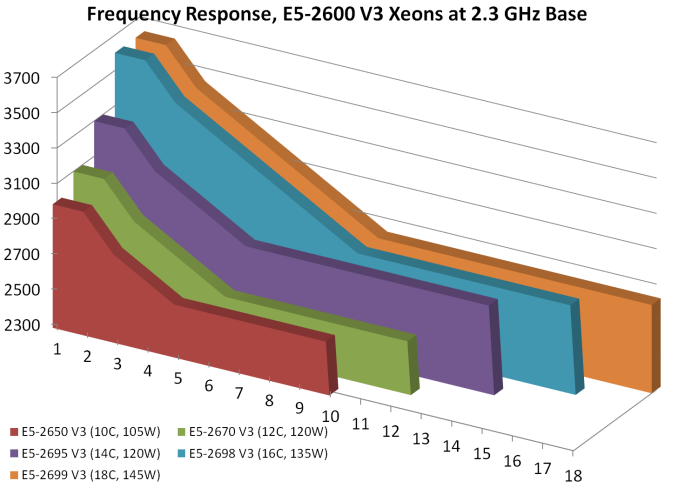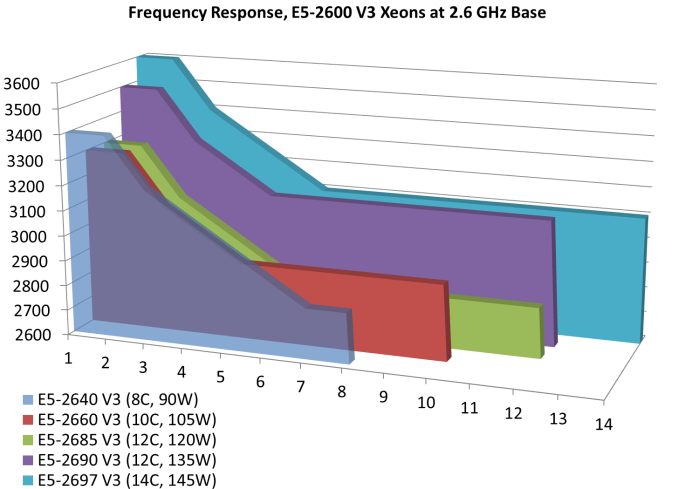Intel Haswell-EP Xeon 14 Core Review: E5-2695 V3 and E5-2697 V3
by Ian Cutress on November 20, 2014 10:00 AM ESTE5-2695 V3 and E5-2697 V3 Conclusion
Reviewing CPUs that differ only in CPU count or clock speed but are based on similar architectures is predominantly a point and click affair. The CPU with the higher single core frequency does well in response focused benchmarks, and those with more cores with enough memory bandwidth to support them. For Xeons, the price difference for more cores or more frequency never makes much sense if you calculate the difference in terms of power, but becomes more realistic when the time-to-complete for intensive workloads is taken into account. To throw a spanner into the mix, as Johan found in his Haswell-EP testing, Xeons like the E5-2667 v3 exist to take advantage of higher AVX clock speeds due to increased power headroom, accelerating mixed-AVX workloads more than a higher core-count model which has to reduce frequency to compensate. The E5-2667 v3 therefore costs an extra $1000+ over its nearest core counterpart.
The two CPUs we have reviewed today, the E5-2695 V3 and E5-2697 V3, fall directly into Intel’s 2.3-2.6 GHz product line for Xeon E5-2600 V3 CPUs. This comes across as the main segmentation for Intel’s binning process from 8-core to 18-core, with the main differentiator relating to core count and pricing. The difference in 300 MHz comes at the expense of 25W TDP on paper as well as $278 in the back pocket.
An interesting point to note about the 2.3-2.6 GHz stack is the turbo frequencies. Not all SKUs are made similar:
Buying a 2.3 GHz base frequency processor with more cores does several things aside from the price: raise the peak turbo frequency, extend the turbo frequencies across more cores and increase the power consumption. As a result, buying the next CPU up in the stack affords more than just a couple of extra cores – there is both single thread and multithread performance of interest. With this in mind, it might be worth examining the Xeon range from through a MHz lens next generation rather than a core viewpoint.
On the 2.6 GHz graph, the 8-core model starts with the higher turbo frequency and has a more regular decline, while the 10-core and 12-core are evenly matched until the 12-core reduces to a lower all-core turbo. The peak turbo frequency again lies with the parts with more cores, and thus ends up with more TDP and cost more to purchase.
I showed the 2.3 GHz graph to some of the other editors and they pointed out the obvious differentiator: the 16 core CPU has a significant MHz advantage from 1-8 core loading over the 14C variant. For any software with a variable threaded load, the 16 core would push the performance and be on par with the 18 core. The price difference between the 14 core model and the 16 core model is nearly $1000, making budgets and workloads being important factors in this decision. The prevalence of multithreaded code is server and workstation environments make the frequency difference extremely important, especially when it comes to the types of workloads that have frequent memory delays and accesses.
This is apt, as our next element of Xeon coverage will be on the 16-core E5-2698 V3. If we can obtain a sample of the E5-2699 V3 as well, it will complete the set.












44 Comments
View All Comments
martinpw - Thursday, November 20, 2014 - link
Of interest - Intel did a custom version of the 2698 called the 2698A for Lenovo which pushes the base clock from 2.3 to 2.8GHz. It is water cooled.aka_Warlock - Thursday, November 20, 2014 - link
14 core gaming benchmarks!???!! Wtf?? Who the f*** cares?? Where are the virtualization benches??? Ffs... This is just too god damn poor.wallysb01 - Thursday, November 20, 2014 - link
And I’m pretty sure this has been a main complaint through out this whole E5-2600v3 review, but no action to fix it.SanX - Thursday, November 20, 2014 - link
You take 4790k overclicked to 5GHz and it will win most of single chip benchmarks lolname99 - Thursday, November 20, 2014 - link
"If it happens in a core as part of the logic or caches, that core can be fused off and the die can sold as a lower core part. This is how yields are improved, by reusing the dies that have errors in removable sections."Is this REALLY the case? We've heard this claim for years, but the only case I know of where it's actually been verified is when AMD was selling 3-core CPUs harvested from 4-core dies.
The reason I am dubious is that, if this is such a great system for increasing profits, how come the ONLY place it ever seems to be used is in Intel's server models?
POWER does not sell dies with random numbers of cores. (Or more precisely they talk about 6, 8, 10 and 12 processor variants but, as far as I can tell, each one of these is a separate die. Certainly they have showed the die shots for the 6 processor version.)
ARM does not do this. There are, as far as I know, no ARM phones that save a buck by using three cores harvested from a four core die, even though that would make sense for many markets and many use cases.
Even Intel does not do this outside Xeons. It's the same story as ARM --- given Intel's crazy market segmentation, again there'd certainly be a market for 3-core i7's harvested from 4-core i7's and priced appropriately.
looncraz - Friday, November 21, 2014 - link
From my understanding, some higher models with defects are binned to lower models even if specific dies exist for those lower models.For instance, it could be the case that some i3s are binned i5s, but it would probably be only a few percent of the total number of chips.
chekk - Thursday, November 20, 2014 - link
Power consumption delta is still undesirable. Please Ian, Ryan et al, go back to separate idle and load measurements.kordian - Friday, November 21, 2014 - link
Again, why are there no database scalability benchmarks or virtualization benchmarks? Redis is single-threaded, so of course a high-clocked desktop processor will win - it doesn't take advantage of the main strength of these processors - their huge number of cores. Can we please drop the gaming benchmarks on these and get some benchmarks that reflect the use of a 36 core dual socket box.antialienado - Friday, November 21, 2014 - link
This is an important idea that Anandtech should implement to differentiate itself and add value: Create an Anandtech designation for processors.It could be based on performance, and some common metrics, number of cores, , and many features, but it should be consistent between generations.
Today is easy to get lost. I lost track of many, many meaningless names. Haswell, Ivy Bridge, Sandy Bridge, Vishera, E5-2695 V3 means nothing to me. Too many generations, too many names, conveying too little information.
When I see an article title, saying E5-2697 V3, I don’t get a clue about if this is a portable processor, a desktop, bang for the buck, server, a top processor, review worth of my time, of just a random processor being reviewed just for the sake of making content.
Ok, the title on THIS article says at least that it is a 14 cores Xeon processor, but that is not the point. The point is that ANY article should be clear about what it does review. It does not matter if the title spoils the conclusion by telling the processor performance right on the title. I want information, not a mystery story. The article will explain why it got the designation it got.
There are many dimensions explaining the performance of each processor. Single threaded performance, multi threaded, energy efficient, portable at notebook level, or at tablet/phone level, locked/unlocked, gaming, office, server, workstation, socket compatibility, GPU integrated, etc.
But processor naming make little or no attempt to clarify any of those variables.
I would prefer sockets being referred by year of introduction, features, type of memory, etc; not by another meaningless jungle naming. I already lost track of soo many designations, and each year it gets worse, more varied and confusing.
Anandtech already haves some classifications on GPU and processors based on similar performing. It should be converted into an Anandtech rating, for clarity.
Anandtech should create a naming scheme not making a difference between AMD and Intel when it does not matter (like on performance).
Of course, it would necessarily have unavoidable flaws, but any system would be better that the official naming, and lack of coherency between generations and manufacturer.
Maybe other sites start adopting Anandtech designation.
dave1231 - Friday, November 21, 2014 - link
$0.10 per kwh? Try $0.28 per kWh in the UK then nearly triple the running costs. This is why we are so much better at not global warming.